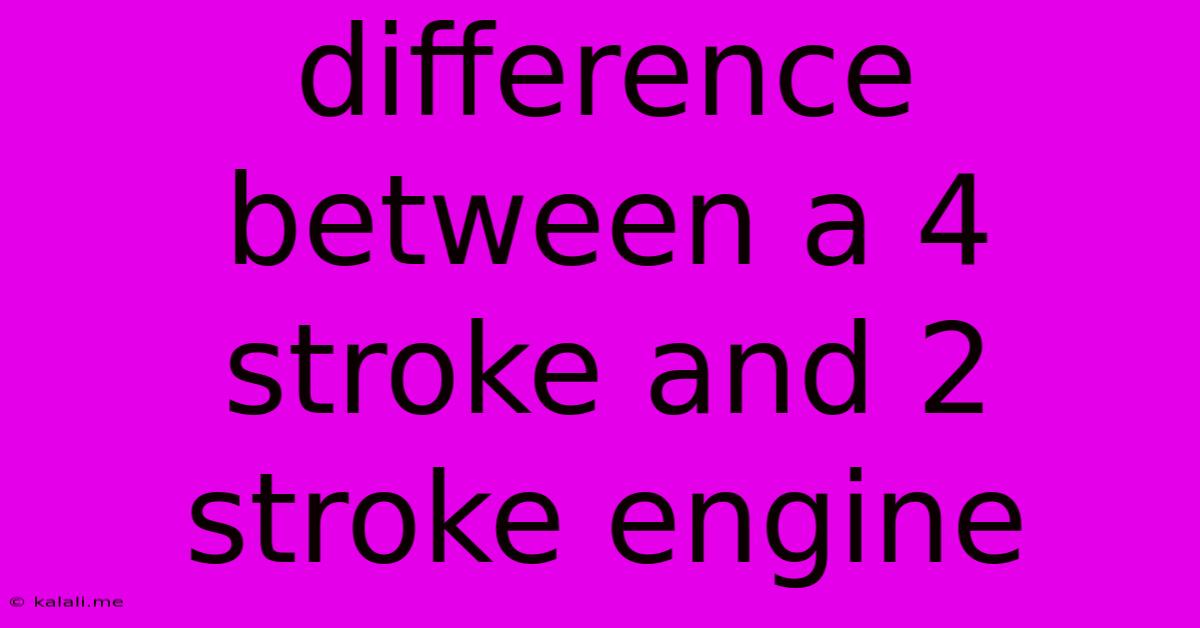Difference Between A 4 Stroke And 2 Stroke Engine
Kalali
May 19, 2025 · 3 min read

Table of Contents
The Great Debate: 4-Stroke vs. 2-Stroke Engines
Choosing between a 4-stroke and a 2-stroke engine often comes down to specific needs and applications. Both engine types have their own strengths and weaknesses, making them suitable for different tasks. Understanding the core differences is crucial for making an informed decision. This article will delve into the intricacies of each engine type, highlighting their operational mechanisms, performance characteristics, and environmental impact.
What are the key differences between a 4-stroke and a 2-stroke engine? The fundamental distinction lies in the number of piston strokes required to complete one combustion cycle. This difference significantly impacts power delivery, fuel efficiency, and emission levels.
Understanding the 4-Stroke Engine Cycle
The 4-stroke engine, prevalent in automobiles and many other applications, completes its combustion cycle in four piston strokes: intake, compression, power, and exhaust.
- Intake: The piston moves downward, drawing a fuel-air mixture into the cylinder.
- Compression: The piston moves upward, compressing the fuel-air mixture, increasing pressure and temperature.
- Power: The compressed fuel-air mixture is ignited by a spark plug, causing rapid expansion and pushing the piston downward, generating power.
- Exhaust: The piston moves upward again, expelling the burned gases from the cylinder.
Advantages of 4-stroke engines:
- Higher fuel efficiency: The distinct phases allow for more complete combustion, leading to better fuel economy.
- Lower emissions: Cleaner burning translates to fewer harmful emissions.
- Longer lifespan: The smoother operation contributes to greater engine longevity.
- More power at lower RPMs: Produces greater torque at lower engine speeds, making it suitable for vehicles requiring pulling power.
Understanding the 2-Stroke Engine Cycle
The 2-stroke engine completes its combustion cycle in two piston strokes: compression and power. This streamlined process allows for a higher power-to-weight ratio, but it comes at a cost.
- Compression & Power (combined): As the piston moves upward, it compresses the fuel-air mixture. Simultaneously, the upward movement also uncovers ports in the cylinder wall, allowing fresh fuel-air mixture to enter while expelling the exhaust gases. Then, the spark plug ignites the compressed mixture, driving the piston downward.
Advantages of 2-stroke engines:
- Lightweight and compact: Fewer moving parts and simpler design result in a smaller and lighter engine.
- Higher power-to-weight ratio: Generates more power for its size and weight.
- Simpler design: Fewer components simplify maintenance.
Disadvantages of 2-stroke engines:
- Lower fuel efficiency: Incomplete combustion leads to higher fuel consumption and lower efficiency.
- Higher emissions: Unburnt fuel and oil are expelled with the exhaust gases, resulting in significant pollution. Modern 2-stroke engines with advancements in lubrication technology and fuel injection have addressed this issue to some degree.
- Shorter lifespan: The constant stress on components due to less refined combustion leads to shorter lifespan than in 4-stroke engines.
- Requires specialized lubricants: The mixing of oil and fuel is essential for lubrication, hence the need for specific 2-stroke oil.
Choosing the Right Engine: Applications and Considerations
The best choice between a 4-stroke and 2-stroke engine depends heavily on the intended application.
-
4-stroke engines are ideal for applications requiring fuel efficiency, lower emissions, and longer engine life, such as automobiles, motorcycles, and larger machinery.
-
2-stroke engines are favored where lightweight and compact design, and high power-to-weight ratio are paramount, such as chainsaws, some motorcycles, and smaller outboard motors. Technological advancements are leading to cleaner-burning 2-stroke engines, mitigating some of the environmental concerns.
Ultimately, the decision hinges on prioritizing specific needs – whether it's fuel efficiency, environmental impact, power output, or size and weight. Understanding the inherent differences between 4-stroke and 2-stroke engines empowers you to make an informed choice suitable for your specific requirements.
Latest Posts
Latest Posts
-
Do Washing Machines Heat The Water
May 19, 2025
-
Can You Have Intercourse In Ramadan
May 19, 2025
-
Can I Drink Expired Tea Bags
May 19, 2025
-
How Do You Get Diesel Smell Out Of Clothing
May 19, 2025
-
Is Tomato Paste And Tomato Puree The Same
May 19, 2025
Related Post
Thank you for visiting our website which covers about Difference Between A 4 Stroke And 2 Stroke Engine . We hope the information provided has been useful to you. Feel free to contact us if you have any questions or need further assistance. See you next time and don't miss to bookmark.